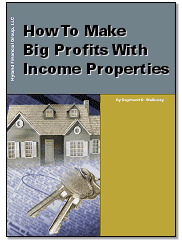And Not Take A Bath


Special Report by Joe Brillante & Lou Castillo
When referring to buying wholesale properties from an investor, it is often commented: "Buyer Beware!" The feeling is that many of the wholesalers in the field are unscrupulous, and will take advantage of unwary buyers. The truth is that most wholesalers are very ethical and provide a valuable service. The trick is to be able to evaluate each deal to make sure it is profitable for YOU.
Don't be scared to purchase a deal because the wholesaler may be unethical. This could also be true if you were dealing with the original home owner. Instead, what makes more sense is to know how to fully evaluate a deal, then purchase the deal that makes sense - that way no one can get the best of you. So how do you evaluate a deal?
First of all, you have to look at a wholesaler just like any other home seller in the field. No better, no worse. You don't try to buy a house from a homeowner, and ask the homeowner to tell you whether it's a good deal or not. You expect them to advertise the best points, and you'll determine based on your criteria, if it works or not. You should approach wholesale buying the same way. Assume the data that a wholesaler gives you is all 100% accurate - only to determine which houses you'll go to look at in more depth. In other words, if based on the info they provided you, you're not interested, don't pursue any further.
Now, once you've gone to see the property for sale, if you're still interested, you have to verify all the information. At this point you have to plug in your own figures, do your own calculation, and see if the deal works. If you do that, you're no longer at the mercy of the wholesaler. You'll feel empowered to pick and choose, and you won't be worried.
The first thing to do is verify the
ARV (After Repaired Value). Someone told me the other day that they didn't believe the ARV in another wholesaler's flyer because the house in the picture didn't look like it would have that kind of value. Frankly, that's no way to evaluate a deal. Using just your eyeball you could either under or over estimate its value. I have been amazed at some of the prices that I have sold small houses - many times it's all about the area, and the craftsmanship of the rehab. The only way to determine the ARV is to look at comps.
Evaluating Comps
Any wholesaler worth his salt will give you the comps used to determine the ARV (if they don't I would question how they determined the ARV in the first place). The first thing you want to look at is how far away they are from subject property, and how old they are. Appraisers use 1 mile and 1 year. As much as possible, we try to use ½ mile and 6 months.
Next, go drive the comps. Is the neighborhood - or even the street - the same as the one you're looking at. For instance, if the house you're looking at is on a street with a lot of boarded up properties, and the houses that are inhabited are all run down, but the comp is on a beautiful street full of rehabs, then it is not a true comp. Same is true for evaluating the house itself against the comp. Are they basically the same house? Obviously, the comp is going to look great - it has probably already been rehabbed. That's OK because you're trying to figure out what your house will be worth AFTER rehab as well. But is the construction essentially the same? You can not compare a small frame, plain-jane cottage with no architectural design, to a huge brick multi-dimensional mansion - unless you've calculated enough in your rehab to get your house to look the same when it's done. What you want in a comp is similar size, similar number of bedrooms and baths, similar design, same frame or brick, etc to what your home will look like when you're done. We've bought houses for rehab that did not look like the comp when we bought it, but we knew that it would after the rehab because we would add a bath or a bedroom, and would change the facade of the house - but our rehab budget reflected that as well.
Now sometimes, there are no houses that are exactly like the one you're looking at. That doesn't mean that you can't use the comps at all. It just means that you have to make a ARV price adjustment. Think of yourself as the ultimate homeowner. How much of a price drop will it take for them to buy your house over the competition if your house is different? How significant is the difference? For instance, one California contemporary house in a neighborhood of Craftsman style homes will be very difficult to sell, so you'd have to drop the price significantly. On the other hand, a fenced yard versus no fence will not affect the value much.
Finally, if you're not comfortable with the data that the wholesaler gave you, go get some more. If you don't have access at home, go to GaREIA and use their tax record databases to see what's selling in the area. You can go one step further and ask a Realtor to pull comps from MLS (the tax records are more comprehensive because they have all houses that sold including FSBO's, but the Realtors have access to more current data). You're probably going to find a fairly wide range of prices. We throw out the extreme high and the extreme low, and look for the median range price at which most houses are selling.
With all of this work done, you should KNOW the ARV. You'll no longer have to guess whether the wholesaler properly evaluated it for you or not. So what's the rest of the formula?
Calculating Your Price
Just like dealing with a homeowner seller, you can only pay what you can pay. It doesn't matter what the wholesaler is asking. So let's figure it out. The formula we use is:
ARV - Repairs - Buy/Sell/Hold (B/S/H) Costs - Profit
= Maximum Allowable Offer
So you already know the ARV. Repairs are a little more difficult, because everyone has a different list in their head of what needs to be done, how elaborate the work needs to be (e.g. tile versus linoleum; carpet versus hardwoods; Corian versus laminate), and the cost of the contractors to do the work. We try to come up with a fair middle of the road figure that we advertise as a wholesaler, but truly, it's meant to be a guide, not an absolute. You have to determine your own repair number. Our Streetwise A-Z Start-Up Kit for Real Estate Riches course (
www.atozrealestateriches.com) provides a worksheet for determining renovation costs quickly and easily.
B/S/H costs are all the closing costs when you buy the property (title work, attorney's fees, title insurance, survey, loan origination fee, appraisal, etc), the closing costs that you pay for your buyer when you sell, the realtor commissions or marketing costs, and the costs to hold the property (debt service, taxes, insurance, utilities). We have found that a good average for all of that is about 15% of the ARV. It could be higher or lower for you based on the cost of money, and how you plan to sell your house. But as a rough gauge, the 15% rule seems to work.
The fun part is the profit. How much do you want to make in this deal. Of course, we'd all like to make $100,000 in every deal, but we'd never buy a property if we always plugged in that number. I recommend that you plug in the minimum amount that you would accept and still be happy. Using that figure you should be happy either way:
I bought the house at the price that will give me that profit - OR - I couldn't buy this property because I wouldn't make enough profit. You don't want to kick yourself later saying I really would have done the deal for $5,000 less, now I missed the opportunity.
But remember, this is your maximum price. You still have one more step...
Negotiating
Unlike the grocery store, you can negotiate on price. The wholesaler has a spread and a profit requirement that he can work with as well. The trick is to negotiate the best deal where both sides are happy. Let me tell you how it works from the wholesaler's side. If we have a hot property, and a lot of interest, we're not too negotiable on price. In fact, we've even accepted offers over the asking price. If the property hasn't had too much interest, we're far more negotiable. It's the law of supply and demand.
If you determine that you need to buy at a price lower than the wholesaler is asking, submit an offer. If nothing else, it at least starts the negotiating process. We've had buyers offer less than we paid for the house - so obviously we pass. But we almost always give a new price that we may be able to work with. The risk of going too low on your part is that the wholesaler may accept another offer in the meantime, and you never get a chance to negotiate. Bottom line, be fair and up front, and it will work out for the best. But always make an offer on a house you're interested in. You never know. You may get your price!
How much should a wholesaler make?
Sometimes it may seem that the wholesaler makes a lot of money for not doing anything to the house (usually not even take title). But you have to remember the marketing effort that goes into attracting the motivated sellers, and the time requirement to sift through all of the deals, visit all the houses, and to negotiate all the deals, to find the few that can be offered on the wholesale market.
We've purchased numerous wholesale deals in our careers. We've never cared what the wholesaler made because we negotiated a deal that worked for us. We were happy to pay the fee - as long as the total cost of the deal worked.
Remember, do your own due diligence. Review the comparable sales. Make sure they are truly comparable to the subject property. Drive by each one. Get a feel for the neighborhood, and what you plan to do. Determine your own costs. The wholesaler is providing an average. Your actual costs may be higher or lower. Determine the price that works for you, then negotiate your best deal. When you follow this process, you'll never worry that someone has taken advantage of you because you'll know for sure that the deal is profitable.
Best of fun, happiness and success!
Joe Brillante & Lou Castillo
Please feel free to forward this information to anyone you think could benefit from it!
Copyright 2003-2004 Azlan Adnan Legal Notice



































